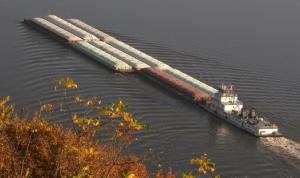Waterways offer a highly efficient system for transporting grain to major export ports in the United States. Through a complex system of rivers and connected waterways, farmers across much of the grain belt have the ability to move grain cost effectively and quickly to domestic and international markets. Fed by the network of highways and rail lines leading to grain elevators along the river system, the U.S. internal waterways system has long been a major competitive advantage in world trade.
An estimated 60 percent of U.S. grain exports travel on U.S. waterways en route to export grain elevators for inspection and loading onto bulk cargo ships, according to The National Waterways Foundation, a group addressing policy issues related to America’s inland waterways system. Corn and soybeans make up the majority of the grain moved on U.S. waterways.
The U.S. Army Corps of Engineers (commonly known as “the Corps�), a U.S. federal agency delivering public engineering, design and construction management services, maintains the infrastructure of U.S. waterways, including channels, harbors, ports, locks and dams. To maintain mandated channel depths and ensure safe navigation, the Corps oversees construction and dredging projects at an average annual cost of nearly $1.5 billion.
The Mississippi River system is the largest waterway system used by U.S. farmers. Running from north to south, this river-based transportation is a “super highway� for moving grain. It connects 31 states to export elevators and other commodity storage tank facilities. Grain elevators located at many points along the Mississippi River system provide farmers access points for marketing their crop. These elevators load grain arriving by highway and railway onto barges for delivery to export ports in the Lower Mississippi River Port Complex, such as the Port of New Orleans.
In addition, the Pacific Northwest region of the United States uses the Columbia River to move grain and other products westward to Oregon and Washington export grain elevators.
Waterways offer a major advantage in freight costs by moving large volumes of grain over long distances for less than other transportation modes. For instance, a river barge can haul 16 times the tonnage of a rail car and 70 times of a highway tractor-trailer.
Seasonal weather conditions like winter storms and extended periods of drought can impact river barge movement and volume, yet most of those issues are alleviated through planning and management. If necessary, grain shipments can divert to highways and possibly railroads.
When choosing U.S. grain, international buyers can have confidence in the balanced U.S. transportation system for moving grain efficiently from the U.S. interior to export ports. The movement of large quantities of grain is supplemented by the efforts of grain elevators to keep supplies moving and the Corps to maintain and improve navigation along the river system.



